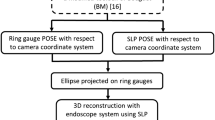Abstract
In this paper, a method is proposed that improves the focal length estimation in an augmented reality surgical guidance system for procedures involving a stereoscopic surgical microscope. Firstly, we show the sensitivity of a photogrammetric calibration method towards the detection of 2D markers in the projected calibration image and the markers’ positional accuracy on the calibration object, both of them affecting the accuracy of the focal length estimate. Secondly, we propose a hybrid method using a photogrammetric method for pre-calibration and a number of self-calibration based methods to further optimise the focal length estimate. The results of the reported experiment, evaluating the proposed method, show a significant improvement in the calibration error of around 0.2 pixels as compared to calibrating each camera separately using a photogrammetric method only.
Access this chapter
Tax calculation will be finalised at checkout
Purchases are for personal use only
Preview
Unable to display preview. Download preview PDF.
Similar content being viewed by others
References
Tsai, R.: A versatile camera calibration technique for high-accuracy 3D machine vision metrology using off-the-shelf TV cameras and lenses. IEEE Journal of Robotics and Automation 3(4), 323–344 (1987)
Faugeras, O., Luong, Q.T., Maybank, S.: Camera self-calibration: Theory and experiments. In: Sandini, G. (ed.) ECCV 1992. LNCS, vol. 588, pp. 321–334. Springer, Heidelberg (1992)
Lourakis, M., Deriche, R.: Camera self-calibration using the singular value decomposition of the fundamental matrix. In: 4th Asian Conference on Computer Vision, vol. 1, pp. 403–408 (2000)
Edwards, P., King, A., Maurer, C., de Cunha, D., Hawkes, D., Hill, D., Gaston, R., Fenlon, M., Chandra, S., Strong, A., Chandler, C., Richards, A., Gleeson, M.: Design and evaluation of a system for microscope-assisted guided interventions (MAGI). IEEE Transactions on Medical Imaging 19, 1082–1093 (2000)
Caversaccio, M., Garcia-Giraldez, J., Gonzalez-Ballester, M., Marti, G.: Image-guided surgical microscope with mounted minitracker. The Journal of Laryngology & Otology 121, 160–162 (2007)
Barreto, J., Roquette, J., Sturm, P., Fonseca, F.: Automatic camera calibration applied to medical endoscopy. In: British Machine Vision Conference, BMVC 2009 (2009)
Klein, G., Murray, D.: Parallel tracking and mapping for small AR workspaces. In: International Symposium on Mixed and Augmented Reality, ISMAR 2007 (2007)
González-García, G.: Optimised Calibration, Registration and Tracking for Image Enhanced Surgical Navigation. PhD thesis, University of East Anglia, United Kingdom (March 2010)
Heikkilä, J., Silvén, O.: A four-step camera calibration procedure with implicit image correction. In: IEEE Computer Society Conference on Computer Vision and Pattern Recognition (CVPR 1997), pp. 1106–1112 (1997)
Lapeer, R., Chen, M., Gonzalez, G., Linney, A., Alusi, G.: Image-enhanced surgical navigation for endoscopic sinus surgery: Evaluating calibration, registration and tracking. The International Journal of Medical Robotics and Computer Assisted Surgery (IJMRCAS) 4(1), 32–45 (2008)
Zhang, Z.: Flexible camera calibration by viewing a plane from unknown orientations. In: International Conference on Computer Vision (ICCV 1999), vol. 1, pp. 666–673 (September 1999)
Luong, Q.: Fundamental Matrix and Self-calibration. PhD thesis, University of Paris, Orsay (December 1992)
Sturm, P., Cheng, Z., Chen, P., Poo, A.: Focal length calibration from two views: Method and analysis of singular cases. Computer Vision and Image Understanding 99(1), 58–95 (2005)
Longuet-Higgins, H.: A computer algorithm for reconstructing a scene from two projections. Nature 293, 133–135 (1981)
Armangué, X., Salvi, J.: Overall view regarding fundamental matrix estimation. In: Image and Vision Computing, pp. 205–220 (2003)
Zhang, Z.: Determining the epipolar geometry and its uncertainty: A review. International Journal of Computer Vision 27(2), 161–198 (1998)
Bougnoux, S.: From projective to euclidean space under any practical situation, a criticism of self-calibration. In: International Conference on Computer Vision (ICCV 1998), pp. 790–796 (1998)
Sturm, P.: On focal length calibration from two views. IEEE Computer Society Conference on Computer Vision and Pattern Recognition (CVPR 2001) 2, 145–150 (2001)
Newsam, G., Huynh, D., Brooks, M., Pan, H.P.: Recovering unknown focal lengths in self-calibration: An essentially linear algorithm and degenerate configurations. Int. Arch. Photogrammetry Remote Sensing 31(B3), 575–580 (1996)
Tordoff, B., Murray, D.: Violating rotating camera geometry: The effect of radial distortion on self-calibration. In: 15th International Conference on Pattern Recognition (ICPR 2000), vol. 1, pp. 423–427 (2000)
Hartley, R., Zisserman, A.: Multiple View Geometry in Computer Vision. Cambridge University Press, Cambridge (2003)
Salman, A., Engelbrecht, A., Omran, M.: Empirical analysis of self-adaptive differential evolution. European Journal of Operational Research 183(2), 785–804 (2007)
Omran, M., Salman, A.: Constrained optimization using CODEQ. Chaos, Solitons and Fractals 42(2), 662–668 (2009)
Author information
Authors and Affiliations
Editor information
Editors and Affiliations
Rights and permissions
Copyright information
© 2010 Springer-Verlag Berlin Heidelberg
About this paper
Cite this paper
González-García, G., Lapeer, R.J. (2010). Optimisation of Focal Length Using a Stereoscopic Operating Microscope for Augmented Reality Surgical Guidance. In: Liao, H., Edwards, P.J."., Pan, X., Fan, Y., Yang, GZ. (eds) Medical Imaging and Augmented Reality. MIAR 2010. Lecture Notes in Computer Science, vol 6326. Springer, Berlin, Heidelberg. https://doi.org/10.1007/978-3-642-15699-1_58
Download citation
DOI: https://doi.org/10.1007/978-3-642-15699-1_58
Publisher Name: Springer, Berlin, Heidelberg
Print ISBN: 978-3-642-15698-4
Online ISBN: 978-3-642-15699-1
eBook Packages: Computer ScienceComputer Science (R0)




